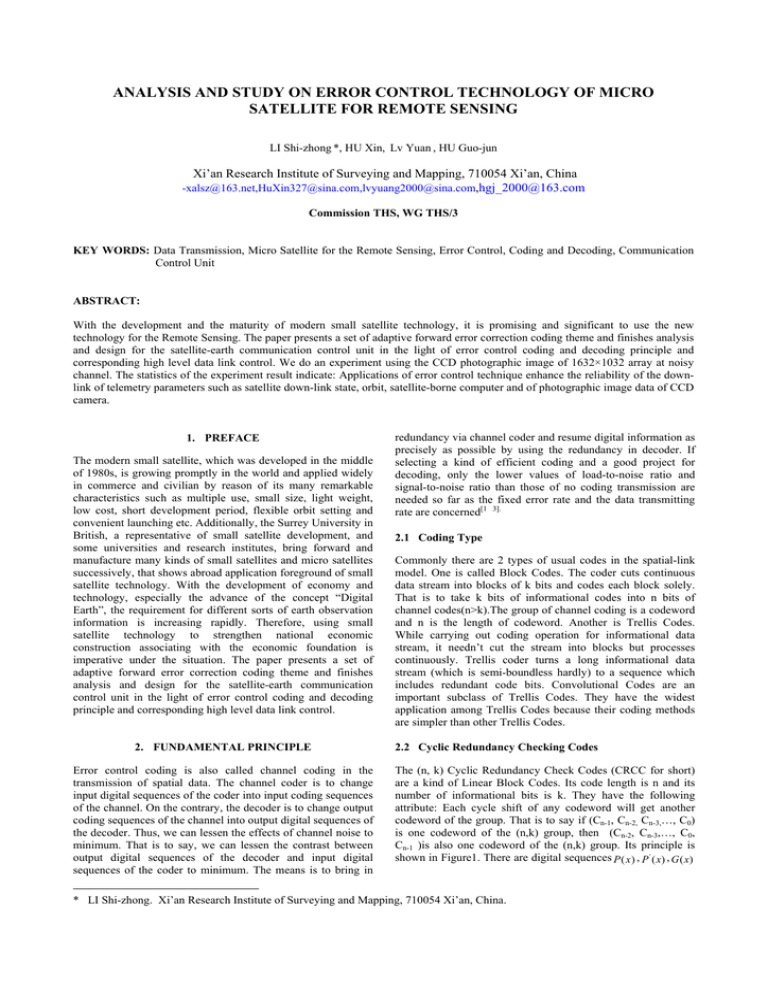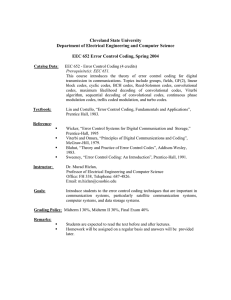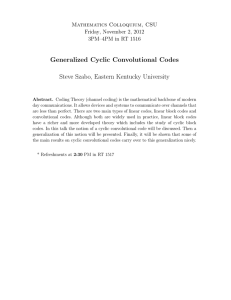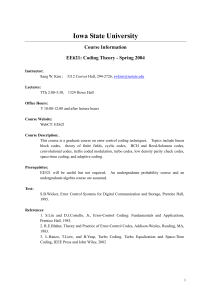ANALYSIS AND STUDY ON ERROR CONTROL TECHNOLOGY OF MICRO ,
advertisement

ANALYSIS AND STUDY ON ERROR CONTROL TECHNOLOGY OF MICRO SATELLITE FOR REMOTE SENSING LI Shi-zhong *, HU Xin, Lv Yuan , HU Guo-jun Xi’an Research Institute of Surveying and Mapping, 710054 Xi’an, China -xalsz@163.net,HuXin327@sina.com,lvyuang2000@sina.com,hgj_2000@163.com Commission THS, WG THS/3 KEY WORDS: Data Transmission, Micro Satellite for the Remote Sensing, Error Control, Coding and Decoding, Communication Control Unit ABSTRACT: With the development and the maturity of modern small satellite technology, it is promising and significant to use the new technology for the Remote Sensing. The paper presents a set of adaptive forward error correction coding theme and finishes analysis and design for the satellite-earth communication control unit in the light of error control coding and decoding principle and corresponding high level data link control. We do an experiment using the CCD photographic image of 1632×1032 array at noisy channel. The statistics of the experiment result indicate: Applications of error control technique enhance the reliability of the downlink of telemetry parameters such as satellite down-link state, orbit, satellite-borne computer and of photographic image data of CCD camera. 1. PREFACE The modern small satellite, which was developed in the middle of 1980s, is growing promptly in the world and applied widely in commerce and civilian by reason of its many remarkable characteristics such as multiple use, small size, light weight, low cost, short development period, flexible orbit setting and convenient launching etc. Additionally, the Surrey University in British, a representative of small satellite development, and some universities and research institutes, bring forward and manufacture many kinds of small satellites and micro satellites successively, that shows abroad application foreground of small satellite technology. With the development of economy and technology, especially the advance of the concept “Digital Earth”, the requirement for different sorts of earth observation information is increasing rapidly. Therefore, using small satellite technology to strengthen national economic construction associating with the economic foundation is imperative under the situation. The paper presents a set of adaptive forward error correction coding theme and finishes analysis and design for the satellite-earth communication control unit in the light of error control coding and decoding principle and corresponding high level data link control. 2. FUNDAMENTAL PRINCIPLE Error control coding is also called channel coding in the transmission of spatial data. The channel coder is to change input digital sequences of the coder into input coding sequences of the channel. On the contrary, the decoder is to change output coding sequences of the channel into output digital sequences of the decoder. Thus, we can lessen the effects of channel noise to minimum. That is to say, we can lessen the contrast between output digital sequences of the decoder and input digital sequences of the coder to minimum. The means is to bring in redundancy via channel coder and resume digital information as precisely as possible by using the redundancy in decoder. If selecting a kind of efficient coding and a good project for decoding, only the lower values of load-to-noise ratio and signal-to-noise ratio than those of no coding transmission are needed so far as the fixed error rate and the data transmitting rate are concerned[1 3]. 2.1 Coding Type Commonly there are 2 types of usual codes in the spatial-link model. One is called Block Codes. The coder cuts continuous data stream into blocks of k bits and codes each block solely. That is to take k bits of informational codes into n bits of channel codes(n>k).The group of channel coding is a codeword and n is the length of codeword. Another is Trellis Codes. While carrying out coding operation for informational data stream, it needn’t cut the stream into blocks but processes continuously. Trellis coder turns a long informational data stream (which is semi-boundless hardly) to a sequence which includes redundant code bits. Convolutional Codes are an important subclass of Trellis Codes. They have the widest application among Trellis Codes because their coding methods are simpler than other Trellis Codes. 2.2 Cyclic Redundancy Checking Codes The (n, k) Cyclic Redundancy Check Codes (CRCC for short) are a kind of Linear Block Codes. Its code length is n and its number of informational bits is k. They have the following attribute: Each cycle shift of any codeword will get another codeword of the group. That is to say if (Cn-1, Cn-2, Cn-3,…, C0) is one codeword of the (n,k) group, then (Cn-2, Cn-3,…, C0, Cn-1 )is also one codeword of the (n,k) group. Its principle is shown in Figure1. There are digital sequences P (x ) , P ' ( x) , G (x ) * LI Shi-zhong. Xi’an Research Institute of Surveying and Mapping, 710054 Xi’an, China. and F (x ) in Figure1.The meanings of the digital sequences and the process of CRCC are as follows. Any binary digital sequence can be expressed as a code polynomial of variable x. For instance, the binary digital sequence 101 100 101 is expressed as the code polynomial Tr ansmi t t er Input Symbols P( x) P´ ( x) In Figure1, P (x ) is the digital sequence polynomial that is sent out, G (x ) is another digital sequence polynomial that is usually called generation Spatial Channel Adding CRC Right Shift P( x) = 1 + x 2 + x 3 + x 6 + x 8 . Receiver F( x) = P´ ( x) + Resi due P´ ( x) + r esi due Judgement CRC Check P´ ( x) + Resi due Resi due =0 G( x) Resi due¡ Ù 0 Output Symbols P( x) Answering Signal CRC CRC= [ P´ ( x) / G( x) ] Resi due [ P´ ( x) / G( x) ] Correct Signal£ R̈esi due =0£ © Resi due Incorrect Signal£ R̈esi due¡ Ù 0£ © Figure 1. The principle of cyclic redundancy checking codes polynomial. It is proven that G (x ) is one and only polynomial whose power is n-k in the group of 2k codewords[2]. Let G (x ) divide code polynomial P ' ( x) here P ' ( x) = P (x ) · [the term with the highest power of G (x ) ]( equal to P (x ) ’s right shift)= x n− k P(x) the quotient be Q (x ) and the residue be R (x ) , then we can get: x n − k P( x) R( x) = Q( x ) + G ( x) G ( x) (1) where x n − k P( x) = Q( x)G ( x) + R( x) Because the result of addition operation of Mod 2 polynomial is the same as that of subtraction operation the above formula can also be expressed as: x n − k P( x) + R( x) = Q( x)G ( x) (2) The residue of x n− k P ( x) / G ( x) is called checkout code polynomial viz. checkout code CRC .It is shown that the residue is 0 when the new code polynomial F ( x) = P ' + residue = x n −k P( x) + R( x) is divided by checkout code generating polynomial G (x ) . G (x) is used on the receiver the same as on the transmitter in the process of error detection. With the received code polynomial H ( x) = F ( x) divided by the code polynomial G (x ) , transmission is right if the residue is 0; otherwise transmission is wrong. If necessary, the judgement results will be returned to the transmitter. According to the judgement results of ground receiver, the satellite transmitter will send the data which was wrongly received again until the judgement results becomes right. 2.3 Convolutional Codes Convolutional Codes, denoted by (n, k, m), are a type of Trellis Codes. In the representation, n denotes code length, k denotes information bit and m denotes coding storage. In the process of coding, information sequence is cut into segments of k code symbols too. After being coded, each segment is transferred to a codeword of n code symbols (n>k), called sub-group . Usually, n and k are smaller integers. Their remarkable character is that the n code symbols outputted in each time unit are not only concerned with the k code symbols inputted at the moment, but also concerned with the code symbols which were inputted in a long period before. The whole coding and decoding procedure is progressed step by step, so the convolution codes are also called interlink codes, in terms of mathematics it is called convolution operation[2], shown as Figure2. Input Sequence Output Sequence R1 ¡ ¡- 0 - 011101 R2 ¡ 1 - 1100110000111 Figure 2 One kind of coder for convolutional codes probability decoding, Viterbi decoding is applied often in satellite facilities. When the restriction length of the coding is not very long, its equipment is relatively simple and its calculation speed is very fast. At present it can reach tens even hundreds of megabits per second. So it is fairly suitable to correcting the random error that nears white Gaussian noise. Viterbi algorithm is a maximum likelihood decoding algorithm which is introduced in the process of solving the decoding trouble of convolutional codes. It does not compare all 2kl traces of possible routes at one time, but does one routes calculation and comparison after one segment’s receiving, then selects one most probable code segment so as to assure that the whole codes serial is one sequence that has maximum likelihood function[2,3]. There are many kinds of representations for convolutional codes. In this paper, we use the trellis diagram to trace the state. Take the encoder in Figure2 for example, with the inputted message M=(1011100), inputted 1 code symbol , and outputted 2 code symbols, the outputted total message is C=(11,10,00,01,10,01,11). If the state is expressed by binary representation of the shift register R1R2 , we can draw out the trellis diagram in Figure3.The trace of bold line is the coding result of the input message 1011100.The encoding begins from the state S0, in which the state of all encoders is 0. The decoding of convolutional codes is sorted into algebraic decoding and probability decoding. Algebraic decoding has fewer users now because it cannot utilize the character of convolutional codes sufficiently. Among many kinds of Node 0 00 1 s0 00 2 s0 00 3 4 00 5 00 6 00 7 s0 11 11 s1 s1 11 11 11 11 s2 01 Input 0 real line 11 00 10 01 01 11 00 10 01 11 11 00 10 Input 1 br oken l i ne 00 10 10 01 01 10 10 01 01 10 s3 Figure 3 Code pattern of (2,1,2) nonsystematic convolutional codes with L equals 5 3. ANALYSIS AND DESIGN FOR THE ERROR CONTROL PROJECT OF THE SATELLITE-EARTH COMMUNICATION CONTROL SYSTEM The core of the satellite-earth communication control system is the satellite communication control unit (SCCU for short) and the ground communication control unit (GCCU for short). They assure that the data up-link and down-link can carry out stable and reliably, and the following functions can be realized assorting with other equipments: error control, communication protocol control, data format conversion, time segments distribution, store and transmission, switching control between receiving and transmitting etc. 3.1 Analysis and Design for the Error Control Project 3.1.1 Error control project for remote sensing data First, presuming that the error rate provided by actual channel is 10E-5,while the systematic error rate required by remote sensing image process is better than 10E-6. On the other hand, the satellite wireless channel has much serious disturbance from many sources, especially the paroxysmal disturbance coming from ground must be taken into account when the antenna’s elevation angle is very low. To meet the requirement of the systematic error rate, some necessary anti-jamming steps should be executed. Convolutional codes have broad applications in spatial communication system. Extraordinarily, the use of large scale integrated coder and soft judgment technique makes convolutional codes the standard of satellite communication channel coding. According to the characters of satellite for earth observation such as high transmission efficiency, plentiful information and short down-link time, we are about to adopt adaptive forward error correction (FEC) technique, which can choose specific coding efficiency in the light of the channel error states. By using convolutional codes at different coding rates such as 1, 3/4, 1/2 and controlling via up-link channel for telecommand, we can make the systematic error rate of the remote sensing channel better than 10E-6 at the 10E-5 channel and make systematic average transmission efficiency higher than 0.8. 3.1.2 Error control project for telemetry and telecommand There are 4 kinds of information in the telemetry and telecommand channel. They are down-link data of telemetry, up-link data of software reinjection, telecommand order and telecommand direct-order. The systematic telemetry and telecommand channel adopts multiple types of error control because the reliability request of its data transmission is very high. First, we use the FEC technique of convolutional codes to make the error rate of actual channel reach 10E-6. On the basis of this, through above analyzed CRC, ARQ technique and the corresponding communication rules, we can make the error codes rate satisfy the telemetry and telecommand request for the system reliability. Communication protocol uses High Level Data Link Control (HDLC for short) regulation which can ensure the high efficiency and high quality in transmission. 3.2 Basic Configuration Communication Control Unit of the Satellite-earth According to the main technique specifications of the satelliteearth communication control unit and the functions that they are to complete, principles of SCCU and GCCU are brought forth respectively as figure 4 and 5. In Figure4, the high-speed serial interface accomplishes bidirectional data transmission between SCCU and transceiver, and completes the switch control between receiver and transmitter and the communication protocol control of HDLC; Forward error correction module selects the corresponding coding rate and codes for remote sensing or telemetry data according to the specific state of spatial channel; SCCU state testing and switching module answers for the state testing of SCCU and its function switch. Ext er i or RAM In Figure5, HDLC serial control unit accomplishes the transmission of bidirectional data between GCCU and transceiver, the implementation of HDLC protocol, and the switch control between receiver and transmitter; Hard-order processing module completes the generation, coding, decoding, verification and authorization of the up-link hard orders; Remote sensing information processing module completes FEC decoding of down-linked remote sensing information and accomplishes the switching among protocols; GCCU selfchecking module fulfills the self-checking function of communication control unit in ground station; The closed circle checking module of the telemetry and telecommand system in ground station accomplishes the self-checking function of the telemetry and telecommand system in ground station; The signal-channel on-line monitoring module mainly completes the inspecting of the performance of signal-channel unit in ground station and that of the transmission quality of satelliteto-ground chain. Order Translation and Editing Modul e 80C152 CPU High Speed Serial Port Dual Path RAM Local Serial Port For war d Er r or Cor r ect i on Codi ng Modul e Ext ended I / O Por t SCCU State Check and Switch Modul e Receiver and Transmitter On Board Management System EEPROM Cortroling Output State Readining Remote Sensing Information Figure 4 The principle of satellite-borne communication control unit RAM ROM Ext ended I / O Por t HDLC I nt er f ace 80386 CPU Terminal Interface Remote Sensing Terminal Remote Sensing Data Interface Receiver and Transmitter Telecommand Terminal Di r ect - or der Modul e Self-checking Modul e Cl osed Ci r cl e Checki ng Modul e Power Supply Modul e State Displaying and Setting Modul e Figure 5 The principle of ground communication control unit 4. RESULTS OF THE EXPERIMENT After the foregoing analysis, we do some simulation using the CCD photographic image of 1632×1032 array at noisy channel. There is a white Gaussian noise channel in the simulation as shown in Figure6. Here we analyze the principle with the part image which is intercepted from the CCD photographic image. With the channel error rate 10E-5, the coding rate 7/8,the length restriction of convolutional codes 7, the noisy image received by the receiving system is shown in Figure6(b).Through error correction, we have Figure6(c)as a result of error correction on noisy image. The statistics of the experiment result indicate: When the channel error rate is higher than 10E-6, increasing the redundancy in structure to correct error can achieve the coding gain to a certain extent and make systematic error rate lower than 10E-6. Table 1 presents the convolutional codes (a) Original image utilization and signal-to-noise ratio by QPSK modulating and soft-decision decoding, and presents the analysis of the systematic error rate, where the length restriction of convolutional codes is 7. In Table 1, when the SNR of input port of the demodulator for receiver is systematic threshold( Eb/N0 =9.6 dB), the systematic error rate is lower than 10E-6 even if the coding rate is 7/8. (b) Noisy image (c) Result of error correction on noisy image Figure 6 Test of error correction Additionally, considering the reliability of transmission for remote sensing data and the improving of the channel utilization rate, the coding rate is controlled by communication control protocols, so that more information is transmitted in limited down-link time. The basic control method is: Firstly the state of channel error rate for remote sensing data down-link is tested by telemetry and telecommand channel. Secondly the systematic error rate R=1/2 R=3/4 R=7/8 R=1 10E-4 4.5 5.6 7.0 9.2 10E-5 5.2 6.2 7.6 9.6 10E-6 5.8 7.0 8.5 11.5 10E-7 7.0 8.3 9.8 12.5 Table 1 The relations of coding rate, signal-to-noise ratio and systematic error rate of convolutional codes 5. CONCLUSIONS Applications of error control technique hereinbefore mentioned enhance the reliability of the down-link of telemetry parameters such as satellite down-link state, orbit, satelliteborne computer and of photographic image data of CCD camera. And they lower the systematic error rate. Additionally, they ensure the implementation of up-linking telecommand orders such as the opening and shutting of the camera, computer switching and software reinjection. The error control technique is one of the powerful technical ways for the wellbalanced operation of the satellite and data management on the coding with stronger ability of error correction is used through up-link order to control SCCU when the state of channel is poor; the coding with higher utilization rate is used when the state of channel is better. ground. With the development of research and application on spacecraft such as data relay satellite, navigation satellite, small satellite constellation , error control technique becomes the valid way of ensuring the reliable data transmission of the chain between satellites, the chain between earth and satellite and lowering error rate. REFERENCES: [1] JIA Shi-lou, GU Xue-mai and WANG Gang. Scout and Communications of Spacecraft. Beijing: Aerospace Publishing House, 1997.( in Chinese) [2] GUO Ti-yun, LIU Zeng-ji and WANG Xin-mei. Data Transmission. Beijing: Publishing House of the People’s Post and Telecommunications, 1998.( in Chinese) [3] SI Guo-xin. Satellite Communication Systems. Beijing: Aerospace Publishing House, 1993.( in Chinese) [4] CHEN Fang-yun, JIA Nai-hua. Satellite Telemetry and Command Manual. Beijing: Scientific Publishing House, 1992.(in Chinese) [5] PAN Xi-zhe, WANG Xin-min, et al. Landsat Remote Sensing in China. Beijing: China Remote Sensing Ground Station, 1994.( in Chinese) [6] Li Shi-zhong, Hu Xin and Chen Hong. The Application of Modern Small Satellites in the Field of Earth Observation. Yantai: Chinese Academy of Space Technology, 1999. [7] Lin lai-xin. Modern Small Satellites and Its Key Technology. National Air Intelligence Center, 1997. [8] Grahn S, et al. Automated Microsatellites and Ground Station—a Low-Cost Tool for Space Science. Beijing: 47th International Astronautical Congress, 1996. ACKNOWLEDGEMENTS : We thank very much for the support and help from Professor Gu Xumay and Xu Guodong in Harbin Institute of Technology, Professor Le Junguo in Chinese Academy of Space Technology, Dr. Wan Zhilong in South Changjiang River Institute of Remote Sensing Application, and senior-engineer Liang Jialin in Xi’an Research Institute of Surveying and Mapping.



